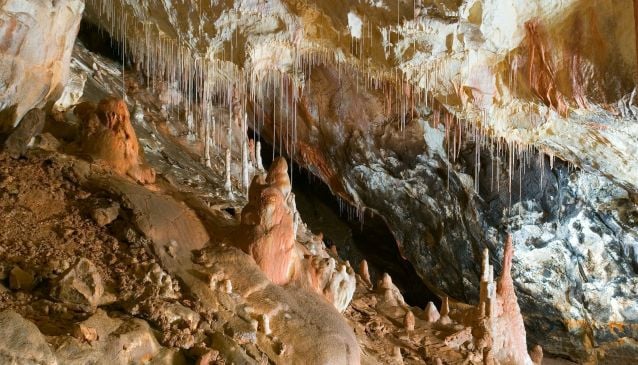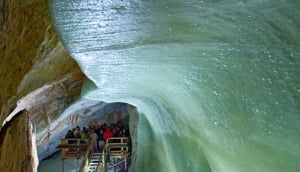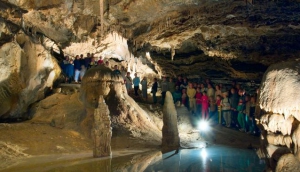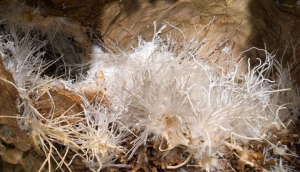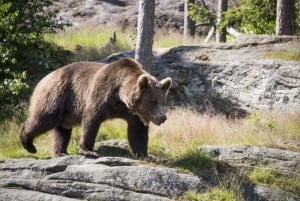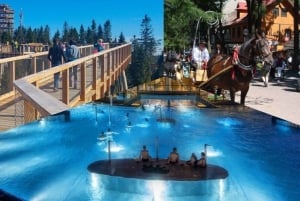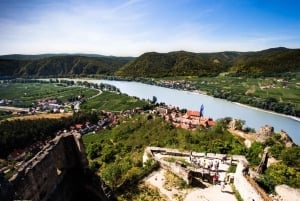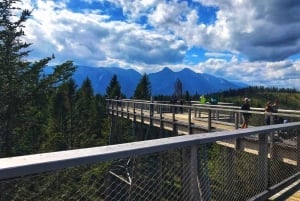The Karst Caves of Slovakia
This makes the site a national treasure chest of unique and remarkable caves.
Book Top Experiences and Tours in Slovakia:
If youʻre booking your trip to Slovakia last minute, we have you covered. Below are some of the top tours and experiences!- Bear Watching Slovakia
- From Krakow: Slovakia Treetop Walk, Zakopane & Thermal Spa
- Vienna: Budapest Day Trip
- From Krakow: Slovakia Treetop Walk and Zakopane Tour
- From Vienna: Wachau Valley Day Tour with Wine Tasting
Spread across the borders of Hungary and Slovakia, the Slovak Karst Mountains contain an abundance of places to be explored. The mountains contain impressive hollowed canyons and forests containing rich flora and fauna. With woodland dominated by hornbeam and oak, the overlapping of flora in the Slovak Karst Mountains leads to the existence of many rare plants and animals within the territory. Wolf, lynx, deer, wild boar, wild cats, badgers and nesting birds can all be found here. But to dig a little deeper into the beauty of these mountains, you have to explore the unique caves that lie beneath.
The striking caves of the Slovak Karst Mountains have various origins, found with different shapes and colour formations, the caves are truly exceptional and puzzling. With 712 caves spread out over an area of 138,000 acres, the caves of Aggtelek Karst and Slovak Karst are part of a UNESCO World Heritage Site along the border of Hungary and Slovakia. Due to the variety of formations and the restricted area, the caves are composed by an extremely rare combination of tropical and glacial climatic effects. This makes it possible to study geological history of the caves over tens of millions of years and makes the site a national treasure chest of unique and remarkable caves.
The site comprises of seven components with caves including: the Domica Cave, Gombasecká Cave, Dobšinská Ice Cave, Ochtinská Aragonite Cave and Jasovská Cave. The caves comprise of limestone plateaus split by deep river valleys and are noted as having the world’s highest stalagmite, aragonite and sinter formations as well as an ice-filled abyss (which is a unique phenomenon for Central Europe, given the territory’s height above sea level).

Also known as the Baradla-Aggtelek Cave, this complex was formed some 65 million years ago. Running for 13 miles, the cave has served as a tourist attraction since 1920. The cave connects Slovakia to Hungary with approximately one fourth on the Slovak side and the rest in Hungary. The complex is an important archaeological site that was inhabited as far back as 500 BC. With a humidity of 95% and a chilling temperature range of 10 and 12°C, the limestone cave is the largest cave system in Europe (!) to consist of spectacular icicles formed by various minerals. With over 14 miles of chartered pathways, the cave can be explored by following the Acheron River.
There are seven entrances to the caverns in total, three of which are in Slovakia (the ‘Devil’s Hole’ and the natural and man-made entrances of Domica) and four in Hungary (the natural entrance at Aggtelek, the man-made entrance at Aggtelek and the man-made entrances at Jósvafo and Lake Vörös). With narrow corridors leading to spacious chambers named with the likes of ‘the Ballroom’, ‘the Concert Hall’ and ‘the Hall of Tigers’, the caves remarkable structure, diverse colours, shapes and forms makes for an attractive sight.

Situated on the western foothill of the Silická Plateau (Slovak Karst National Park), Gombasecká Cave is arguably one of the most picturesque of the caves. Since first being discovered in 1951, 530 metres out of its total 1,525 metres of this spectacular cave have been opened to the public. With a nickname of ‘fairy tale cave’, it is one of the most impressive yet youngest caves of Slovakia, decorated with extraordinary dripstone over several levels. With its unique narrow straw stalactites (mineral-like icicles) reaching lengths of up to three metres, the cave resembles shapes and forms found in fairy tales. The cave is also used for ‘speleotherapy’, a form of salt therapy used for health benefits due to its constant temperature of 9°C and its high humidity of 98%.

First discovered in 1870 by Eugen Ruffinyi, after he braved to enter what was known to exist for years before, this ice cave was only added to the World Heritage Site in 2000. Opening up to the public a year after discovery, the Dobšinská Ice Cave was the first cave to be electrically lit in Europe. Despite its late arrival into the World Heritage List, the cave remains to be phenomenal, filled with scenic ice pillars, waterfalls and lakes. Approximately one third of the caves 1,483 metre-length is open to the public between May and September, where the thickness of the ice floor approaches 25 metres. With a shivering temperature of -1°C, the relative humidity of the cave sits between 96 and 99%. The Dobšinská Ice Cave is not only amongst the most beautiful and richly decorated ice caves in the world, but it is also one of the most important.

The Ochtinská Aragonite Cave is one of only three caves discovered in the world to be filled with aragonite (a carbonate mineral)! This famous and rare cave is jut 300m long, with a tourist circuit of 230m. The ‘Milky Way Hall’ of the cave is the main attraction, being full of white branches and clusters of the carbonate mineral that shine like stars in the Milky Way. This unique natural phenomenon attracts attention through its richness of ornamentation, in particular the iron flowers and bushes. After first being discovered in 1954, the cave opened to the public in 1972. Slightly warmer than the other caves, Ochtinská Aragonite Cave sits at 7°C with a relative humidity between 92 and 97%. The underground beauties of the cave are located in the southern part of Slovakia, near the town of Rožnava.

Famous for it calcite formations and diverse rock shapes, Jasovská Cave is the oldest cave to be publicly accessible in Slovakia, after opening in 1846. Despite this, the lower parts of the cave held undiscovered until 1922 and 1924. Comprised of domes, halls, wall notches and flat roofs, the lower parts of the cave were mainly formed by stagnant water and limestone. Since opening, Paleolithic and Neolithic archaeological artefacts have been discovered in the cave, along with artefacts from the Hallstatt Culture, the most predominant Central European Culture from the 8th to 6th centuries BC. Located on the most eastern projection of the Slovak Karst, the cave can be entered through an entrance on the right hand side of the Bodva River. More than a third of the 2,148-metre long cave is open to the public. Whilst being home to rocks, stones and waterfalls that intrigue and fascinate, the cave is also home to 18 kinds of bats, found mainly in the higher areas of the cave along with a rare cave palpigrade, the only known representative of pseudoscorpions in Slovakia. Cave bear skeletons have also been on the list of paleontological findings in the cave.



